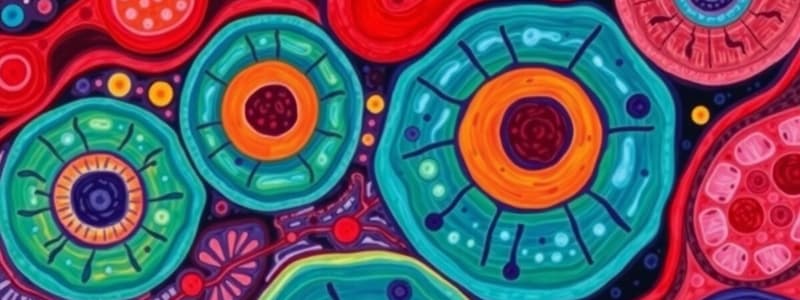Podcast
Questions and Answers
What component distinguishes plant cells from animal cells, providing protection and structure?
What component distinguishes plant cells from animal cells, providing protection and structure?
- Cytoplasm
- Nucleus
- Cell wall (correct)
- Cell membrane
Which process allows water to move across a semipermeable membrane from a low concentration to a high concentration?
Which process allows water to move across a semipermeable membrane from a low concentration to a high concentration?
- Active transport
- Diffusion
- Osmosis (correct)
- Facilitated diffusion
What occurs to a cell when it is placed in a hypertonic solution?
What occurs to a cell when it is placed in a hypertonic solution?
- The cell will swell and possibly burst
- The cell will shrink (correct)
- The cell remains the same size
- The cell will fill with more nutrients
What type of transport requires energy in the form of ATP to move substances into the cell against their concentration gradient?
What type of transport requires energy in the form of ATP to move substances into the cell against their concentration gradient?
Which of the following statements is true regarding the vacuole in plant cells?
Which of the following statements is true regarding the vacuole in plant cells?
What is the primary function of connective tissue in the body?
What is the primary function of connective tissue in the body?
Which type of organism is primarily made up of a single cell?
Which type of organism is primarily made up of a single cell?
What is the role of the mitochondria in animal cells?
What is the role of the mitochondria in animal cells?
Which statement about the nucleus is true?
Which statement about the nucleus is true?
What distinguishes multicellular organisms from single celled organisms?
What distinguishes multicellular organisms from single celled organisms?
Which component of a cell functions as the barrier that holds everything in and allows nutrients in?
Which component of a cell functions as the barrier that holds everything in and allows nutrients in?
What is the primary role of lysosomes within a cell?
What is the primary role of lysosomes within a cell?
Which type of cell is primarily responsible for covering the surfaces of organs?
Which type of cell is primarily responsible for covering the surfaces of organs?
Flashcards
Organism
Organism
A living thing that is made up of one or more cells.
Single-celled organism
Single-celled organism
An organism that is composed of only one cell.
Multicellular organism
Multicellular organism
An organism that is composed of many cells.
Tissue
Tissue
Signup and view all the flashcards
Organ
Organ
Signup and view all the flashcards
Cell membrane
Cell membrane
Signup and view all the flashcards
Nucleus
Nucleus
Signup and view all the flashcards
Endoplasmic reticulum (ER)
Endoplasmic reticulum (ER)
Signup and view all the flashcards
Cell Wall
Cell Wall
Signup and view all the flashcards
Chloroplasts
Chloroplasts
Signup and view all the flashcards
Vacuole
Vacuole
Signup and view all the flashcards
Diffusion
Diffusion
Signup and view all the flashcards
Study Notes
Cells and Body Systems
- An organism is a living thing made of cells.
- Organs in the body are made of tissues, and tissues are made of cells.
Cell
- Cells are the fundamental units of the body.
- An organ is a structure in the body that has a specific function.
- Skin is an example of an organ made of many cells.
Tissues
- Tissues are groups of similar cells that perform a similar function.
- Examples of tissues include muscle tissue, and connective tissue
Organs
- Organs are structures in the body composed of different types of tissues.
- Organs work together to perform complex functions.
Types of Animal Cells
- Connective tissue cells support and connect different parts of the body (e.g., blood, cartilage, bone).
- Epithelial cells cover the surfaces of organs and the body (e.g., skin).
- Nervous tissue cells send signals throughout the body (e.g., brain, pain receptors).
- Muscle tissue cells allow movement (e.g., skeletal muscle, heart muscle).
Single-celled Organisms
- Some organisms (bacteria, viruses, algae) only need one cell to live and function.
Multicellular Organisms
- Multicellular organisms (plants, animals) need many cells to carry out life functions.
Animal Cell Structure
- Cell membrane: surrounds the cell, controls what enters and leaves
- Nucleus: controls cell activities, contains DNA
- Endoplasmic reticulum (ER): produces proteins
- Ribosomes: make proteins
- Mitochondria: produce energy for the cell
- Vacuoles: store substances
- Golgi complex: modifies and packages proteins
Plant Cell Structure
- Cell wall: rigid outer layer providing support and shape
- Chloroplasts: convert light energy into sugars (photosynthesis)
- Vacuole: large storage space for water and other substances.
Cell Membrane Transport
- Diffusion: movement of particles from high to low concentration.
- Osmosis: movement of water from low to high solute concentration.
- Active transport: movement of particles from low to high concentration using energy (ATP).
Cell Functions
- Golgi complex: packages substances for transport
- Mitochondria: energy production
- Lysosomes: break down cellular waste
Studying That Suits You
Use AI to generate personalized quizzes and flashcards to suit your learning preferences.




